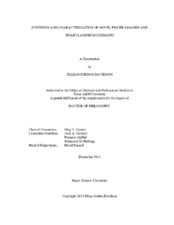| dc.description.abstract | Diarylamido-based tridentate pincer ligands have become an important archetype in transition-metal chemistry and their reactivity has been widely explored. The diarylamido backbone offers rigidity and can be easily tuned to change the steric and electronic properties of the ligand. Motivated by previous successes, efforts were made to expand the scope of pincer ligands developed within the Ozerov group, which historically have been limited to C2V symmetric ligands bearing either two phosphine donor arms or two imine donor arms. New ligands synthesized for this purpose include CS symmetric ligands PNP and PNN ligands.
In an effort to categorize pincer ligands commonly employed in the Ozerov group we set out to compare the redox properties of the ligands and their donor ability towards a metal center. This was a two part endeavor where we (a) obtained cyclic voltammograms for (pincer)MCl compounds of Group 10 metals and (b) measured the IR stretching frequencies of (pincer)RhCO compounds. Our underlying assumptions were that the cyclic voltammograms report on how easy it is to oxidize the ligand (approximates the electron-richness of the ligand) and that the IR stretching frequencies give insight into the “electron-richness” of the metal center (a reflection on the basicity of the pincer ligand). The results of this study suggest that changes to the ligand framework directly affect the level of conjugation and in turn affect the redox potentials and the ν(CO) values in a nearly linear fashion. The more electron-rich a ligand is, (due to direct conjugation from donor substituents on the diarylamido-backbone and from the influence of the donor arms) the more readily it is oxidized and the stronger donor it becomes.
Chemical oxidations have become a rising field of interest. Triarylaminium oxidants are advantageous since they boast modest oxidation potentials and generate chemically neutral amines upon reduction. Our goal was to expand the scope of triarylaminium oxidants bearing non-coordinating carborane anions. A series of oxidizing triarylaminium radical cations were synthesized and isolated as [NAr3]^+[CRB11Cl11]^− salts (R = H, CH3). These salts were prepared by treatment of a neutral amine, Me3SiX (X = OTf, Cl), and Na[CRB11Cl11] (R = H, CH3) with half an equivalent of PhI(OAc)2. | en |


